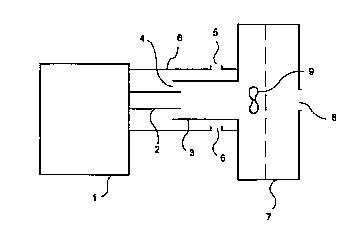Some of the information on this Web page has been provided by external sources. The Government of Canada is not responsible for the accuracy, reliability or currency of the information supplied by external sources. Users wishing to rely upon this information should consult directly with the source of the information. Content provided by external sources is not subject to official languages, privacy and accessibility requirements.
Any discrepancies in the text and image of the Claims and Abstract are due to differing posting times. Text of the Claims and Abstract are posted:
| (12) Patent Application: | (11) CA 2186346 |
|---|---|
| (54) English Title: | CATALYTIC METHOD |
| (54) French Title: | PROCEDE CATALYTIQUE |
| Status: | Deemed Abandoned and Beyond the Period of Reinstatement - Pending Response to Notice of Disregarded Communication |
| (51) International Patent Classification (IPC): |
|
|---|---|
| (72) Inventors : |
|
| (73) Owners : |
|
| (71) Applicants : |
|
| (74) Agent: | SMART & BIGGAR LP |
| (74) Associate agent: | |
| (45) Issued: | |
| (86) PCT Filing Date: | 1995-12-21 |
| (87) Open to Public Inspection: | 1996-08-01 |
| Availability of licence: | N/A |
| Dedicated to the Public: | N/A |
| (25) Language of filing: | English |
| Patent Cooperation Treaty (PCT): | Yes |
|---|---|
| (86) PCT Filing Number: | PCT/US1995/016836 |
| (87) International Publication Number: | US1995016836 |
| (85) National Entry: | 1996-09-24 |
| (30) Application Priority Data: | ||||||
|---|---|---|---|---|---|---|
|
An emissions control system for rich-burn internal combustion engines, includes a reaction chamber (7) for thermal oxidation of
exhaust gas fuel values. A passive means (5, 4) utilizes exhaust flow energy (2) for induction of air into engine exhaust gas, and a duct
(3) transfers the exhaust gas together with the inducted air into the reaction chamber (7) for thermal oxidation. To achieve a high degree
of efficiency the thermal oxidation is facilitated by thorough mixing of air and exhaust gas by recirculation means (9) to insure gas phase
thermal reaction.
Cette invention se rapporte à un système de contrôle d'émissions, qui est destiné à des moteurs à combustion interne à mélange riche et qui comprend une chambre de réaction (7) servant à l'oxydation thermique des valeurs combustibles des gaz d'échappement. Un moyen passif (5, 4) utilise l'énergie (2) de l'écoulement des gaz d'échappement pour obtenir une induction d'air dans des gaz d'échappement du moteur, et un conduit (3) transfère dans la chambre de réaction (7) des gaz d'échappement avec l'air induit, en vue de leur oxydation thermique. Pour atteindre un degré élevé d'efficacité, on facilite l'oxydation thermique en mélangeant à fond l'air et les gaz d'échappement à l'aide d'un moyen de remise en circulation (9), assurant ainsi une réaction thermique de la phase gazeuse.
Note: Claims are shown in the official language in which they were submitted.
Note: Descriptions are shown in the official language in which they were submitted.

2024-08-01:As part of the Next Generation Patents (NGP) transition, the Canadian Patents Database (CPD) now contains a more detailed Event History, which replicates the Event Log of our new back-office solution.
Please note that "Inactive:" events refers to events no longer in use in our new back-office solution.
For a clearer understanding of the status of the application/patent presented on this page, the site Disclaimer , as well as the definitions for Patent , Event History , Maintenance Fee and Payment History should be consulted.
| Description | Date |
|---|---|
| Inactive: IPC expired | 2010-01-01 |
| Inactive: IPC removed | 2009-12-18 |
| Inactive: IPC from MCD | 2006-03-12 |
| Inactive: IPC from MCD | 2006-03-12 |
| Inactive: IPC from MCD | 2006-03-12 |
| Inactive: IPC from MCD | 2006-03-12 |
| Inactive: IPC from MCD | 2006-03-12 |
| Inactive: IPC from MCD | 2006-03-12 |
| Time Limit for Reversal Expired | 2003-12-22 |
| Application Not Reinstated by Deadline | 2003-12-22 |
| Deemed Abandoned - Failure to Respond to Maintenance Fee Notice | 2002-12-23 |
| Inactive: Abandon-RFE+Late fee unpaid-Correspondence sent | 2002-12-23 |
| Letter Sent | 1999-02-01 |
| Reinstatement Requirements Deemed Compliant for All Abandonment Reasons | 1999-01-21 |
| Deemed Abandoned - Failure to Respond to Maintenance Fee Notice | 1998-12-21 |
| Letter Sent | 1998-09-08 |
| Reinstatement Requirements Deemed Compliant for All Abandonment Reasons | 1998-09-01 |
| Deemed Abandoned - Failure to Respond to Maintenance Fee Notice | 1997-12-22 |
| Application Published (Open to Public Inspection) | 1996-08-01 |
| Abandonment Date | Reason | Reinstatement Date |
|---|---|---|
| 2002-12-23 | ||
| 1998-12-21 | ||
| 1997-12-22 |
The last payment was received on 2001-12-21
Note : If the full payment has not been received on or before the date indicated, a further fee may be required which may be one of the following
Patent fees are adjusted on the 1st of January every year. The amounts above are the current amounts if received by December 31 of the current year.
Please refer to the CIPO
Patent Fees
web page to see all current fee amounts.
| Fee Type | Anniversary Year | Due Date | Paid Date |
|---|---|---|---|
| MF (application, 2nd anniv.) - small | 02 | 1997-12-22 | 1998-09-01 |
| Reinstatement | 1998-09-01 | ||
| MF (application, 3rd anniv.) - small | 03 | 1998-12-21 | 1999-01-21 |
| Reinstatement | 1999-01-21 | ||
| MF (application, 4th anniv.) - small | 04 | 1999-12-21 | 1999-12-13 |
| MF (application, 5th anniv.) - small | 05 | 2000-12-21 | 2000-12-20 |
| MF (application, 6th anniv.) - small | 06 | 2001-12-21 | 2001-12-21 |
Note: Records showing the ownership history in alphabetical order.
| Current Owners on Record |
|---|
| WILLIAM C. PFEFFERLE |
| Past Owners on Record |
|---|
| None |